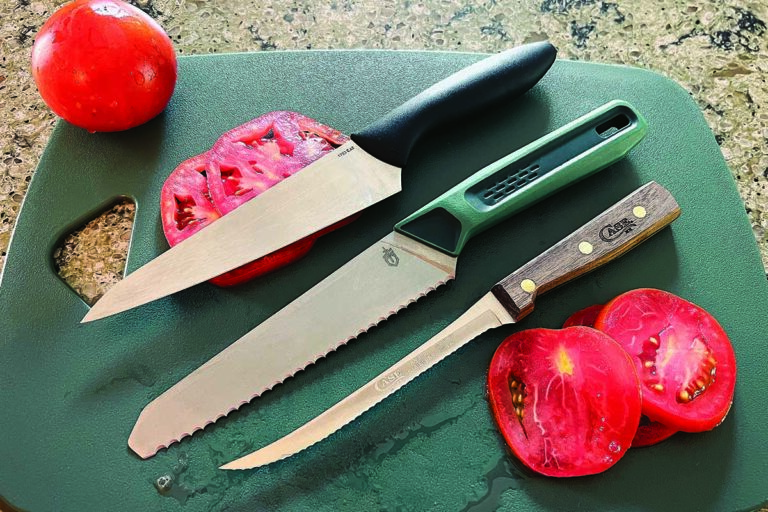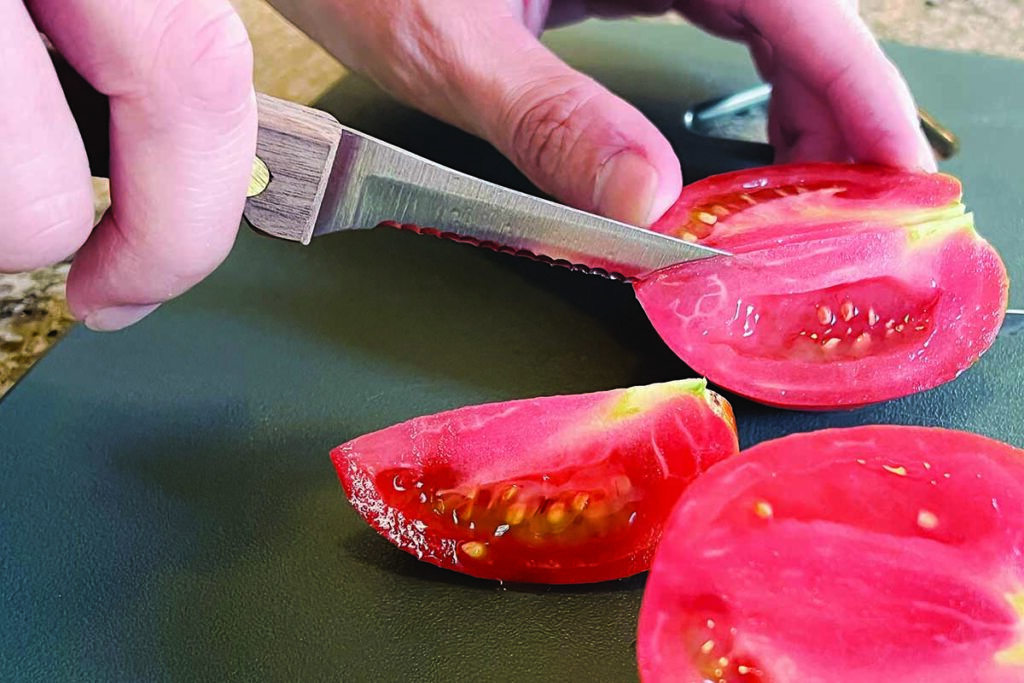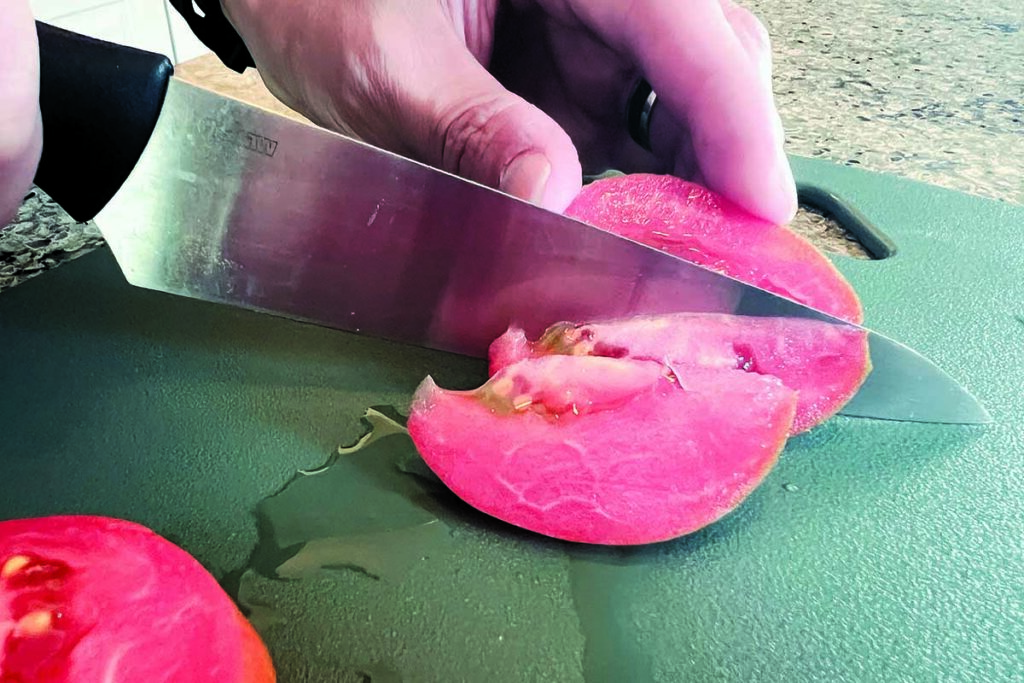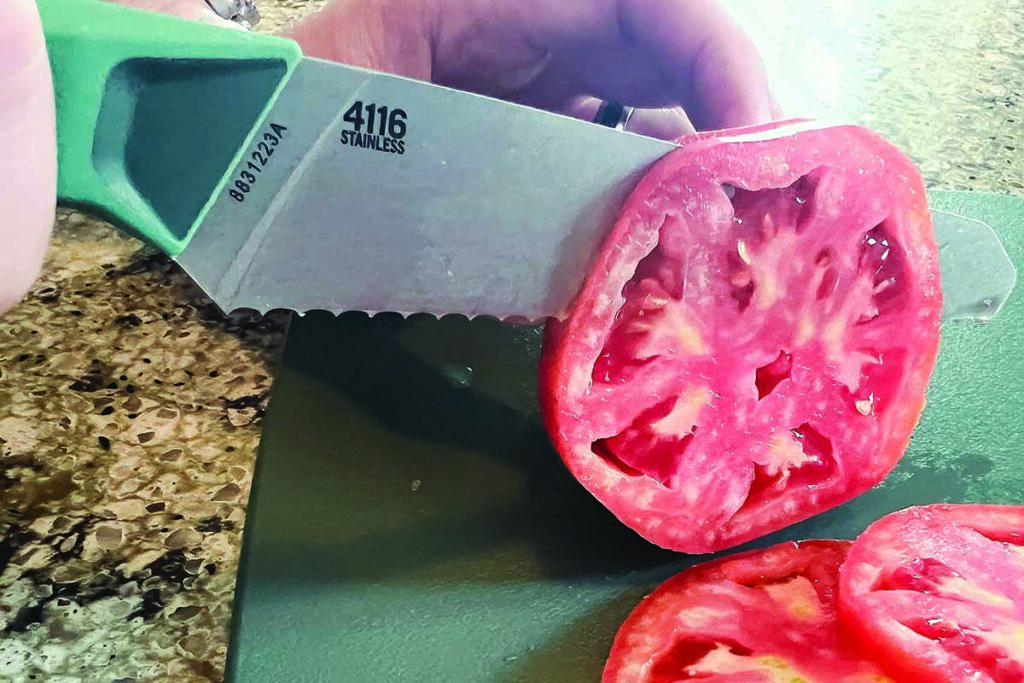
No matter how you slice it, three top tomato knives turn the trick.
Nothing beats homegrown tomatoes and tomato sandwiches, or just simply enjoying them as they are, sliced up with all their juicy goodness. Who doesn’t love a ripe and ready tomato?
Cutting tomatoes requires a very sharp knife. Besides writing for this fine publication, I also have another side hustle of running a sharpening service. I get asked all the time, “How do I know when it is time to have my kitchen knives sharpened?” I always answer with the tomato test. If your knife cannot slice a tomato cleanly without squashing it, then it is time for a sharpening.
Tomatoes have a firm exterior and a squishy/liquid interior. A sharp knife is mandatory to break through the firm exterior. If your knife is dull, it won’t bite right into the exterior but instead will squash it, thus squeezing out the juice and ruining a good slice of succulent tomato.
Sure, any sharp kitchen knife will slice tomatoes and do a fine job of it. But there are specially designed tomato knives that take the work out of perfect slicing. If you do a lot of meal prep involving tomatoes, then you might want to procure one of the following tomato-slicing knives for the occasion.
Case Tomato Slicer

Case Tomato Slicer
Blade Length: 5.5″
Overall Length: 9.25″
Blade Material: Tru-Sharp Stainless
Handle Material: Walnut
Country of Origin: USA
MSRP: $39
Pros
- Hightly effective for tomatoes
- Durable and attractive Construction
- Effortless cutting
Cons
- Limited to specific tasks
The 5½-inch Tomato Slicer from Case is a highly effective tomato knife. It is specifically designed to make quick work of processing tomatoes without damaging them. The 5½-inch blade is slender and has a trailing-point shape. It is hollow ground, fully serrated and Tru-Sharp stainless steel (420 HC stainless). The handle is walnut and features triple-rivet construction for strength and durability. It is a nice-looking knife and part of a larger household cutlery family Case offers with the same blade and handle materials.
Performance wise the knife excels. The serrations cut smoothly but have an aggressive bite that help break cleanly through the tomato’s firm skin. The hollow grind and slender blade aid in sailing through the fruit without collapsing it. The knife is quite effortless in action. Due to the slender, almost minimalist blade width I would limit use of the knife to tomatoes and other similar fruits like grapes and kiwi. It is sort of a specific-use knife and not one you generally grab when you need to cut something in the kitchen. It is more like a hybrid knife. It has a serrated edge but cuts clean and smooth similar to a plain edge knife. MSRP: $38.99. Country of origin: USA.
Kershaw Utility Knife

Kershaw Utility Knife Specs
Blade Length: 6″
Overall Length: 10.6″
Blade Material: DIN 1.4116
Handle Material: Polypropylene
Country of Origin: China
MSRP: $21
Pros
- Versatile for light-to-medium tasks
- Comfortable and Secure Grip
- Affordable
Cons
- Not made for tough tasks
- Very basic design
The Kershaw 6-inch Utility Knife is designed to be a “do-it-all” knife in the kitchen for light-to-medium-duty food prep tasks, and can handle meats, fruits and vegetables with no problem. One look at this knife and the word “basic” comes to mind. It is just a no-frills kitchen knife and I say that not in a negative light but rather a positive one. Sometimes simple is the way to go; it is the most direct way.
The 6-inch blade is DIN 1.4116 stainless steel in a nice brushed-satin finish. The handle has an expanded front section that not only acts as a finger stop but also is shaped in a way that promotes using the pinch grip for more precise control for detail cutting. The handle profile is rounded so it sits in your grip nicely and comfortably with no hot spots to speak of. The material is molded polypropylene and sports a slight texturing to aid in grip retention. As an added bonus, the knife comes with a molded plastic slip sheath to protect the blade when not in use. Because of this, the knife can be stored in a backpack for a camping trip, a drawer of your RV or a kitchen drawer, all without worry of edge damage or accidental cuts.
Due to the very thin blade stock (.057 inch at the thickest), the Kershaw slices tomatoes with surgical precision. The edge bites into the skin and glides right through with very little resistance. The blade is somewhat flexible but not as much as, say, a fillet knife. You are still able to flex the blade a bit, so I would not tackle any tough cutting with it and certainly not torque the handle. The blade shape is adaptable to all sorts of food prep tasks, from meats to vegetables to fruits.
The size is perfect to accompany a larger chef’s knife, for those tasks for which an 8-inch chef’s knife is too big and a paring knife is too small. The major selling points are the basic design, thin blade stock, rounded handle and price. MSRP: $20.99. Country of origin: China.
Gerber ComplEAT Utility Knife

Gerber ComplEAT Specs
Blade Length: 6″
Overall Length: 10″
Blade Material: 4116 German stainless stee
Handle Material: Glass-filled polypropylene
Country of Origin: China
MSRP: $35
Pros
- Multi-use versatility
- Serrated blade stays sharp
- Ergonomics are great
Cons
- Constructed of basic materials
The serrated Gerber ComplEAT 6-inch Utility Knife will handle meats, produce and bread. It’s the perfect complement to the other two models—chef’s and paring knives—in the company’s ComplEAT series.
The 6-inch blade is German 4116 stainless steel for affordability and stain resistance. Commonly used in pocketknives, the sheepsfoot blade is utility friendly. The full flat grind thins the serrations down well without being fragile and gives the edge its bite. A stonewash finish seals the micro pores in the steel to prevent rust from forming easily.
The handle is dual molded, with a hard plastic outer frame and inlays of a softer, grippier rubber-like material. The inlays are inset some to provide an innovative finger groove of sorts that allows you to obtain good handle traction, as your fingers and thumb can rest inside it, helping you to control the knife at all times. Additionally, there is a forward pinch grip/recessed area on both sides of the handle for exact control. The handle perimeter features multifaceted chamfers that not only reduce hot spots but also make the handle feel slimmer by removing bulk. An oblong hole accepts a lanyard or simply serves to hang the knife on a peg, nail or hook when not in use.
The handle color is interesting. Gerber calls it Baltic Haze and is a matte light green with dark green rubber inlays. It is more appealing than standard black and fits in well with the outdoor theme. A matching plastic slip sheath protects the blade and is safe to carry in a backpack.
The ComplEAT handles tomatoes similarly to the Case Tomato Slicer. The serrations allow the blade to immediately bite into the tomato skin and help the edge to remain sharp over time. Unlike the Case, the ComplEAT can be used for other foods, too—cucumbers, onions, chicken, pork, beef and even as a bread knife, including bagels, baguettes and such. It is a true multi-use performer. If you need one knife to tackle a variety of food for camping, it might be the one as the evenly spaced serrations cut smoothly. If you prefer infrequent sharpening, the serrations are for you. Why? The serrations’ scallops are sharp and are protected by the teeth.
More Kitchen Knives:
 NEXT STEP: Download Your Free KNIFE GUIDE Issue of BLADE Magazine
NEXT STEP: Download Your Free KNIFE GUIDE Issue of BLADE Magazine
BLADE’s annual Knife Guide Issue features the newest knives and sharpeners, plus knife and axe reviews, knife sheaths, kit knives and a Knife Industry Directory.Get your FREE digital PDF instant download of the annual Knife Guide. No, really! We will email it to you right now when you subscribe to the BLADE email newsletter.








